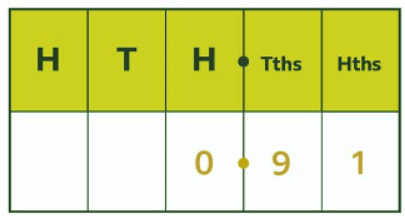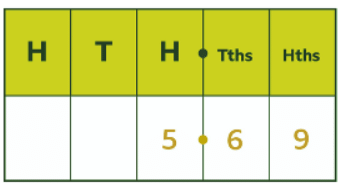Year 5 Exam > Year 5 Notes > Year 5 Mathematics > Equivalent fractions and decimals
Equivalent fractions and decimals | Year 5 Mathematics PDF Download
Understanding Decimals and Fractions
- Decimals and fractions are related.
- Just as fractions have equivalent fractions, decimals also have equivalent fractions.
- Understanding how to write decimals as fractions is important because it helps us understand the place value of the numbers.
- Place value is crucial when converting decimals into fractions. You already use place value names as fractions after the decimal point, such as tenths and hundredths.
- There is a simple method you can follow to convert decimals into fractions.
Examples
Example: 1
Converting a number with two decimal places
How do you convert 0.91?
Sol: You can use the same method.


Example: 2
Converting decimals which are more than 1
How do you convert 5.69 into a fraction?
Sol: Step 1: Put the number into the place value chart. Step 2: Convert the numbers after the decimal point into a fraction.
Step 2: Convert the numbers after the decimal point into a fraction.
Keep the 5 in the ones column as a whole number. This turns the fractions into a mixed number.
The document Equivalent fractions and decimals | Year 5 Mathematics is a part of the Year 5 Course Year 5 Mathematics.
All you need of Year 5 at this link: Year 5
|
45 videos|51 docs|15 tests
|
FAQs on Equivalent fractions and decimals - Year 5 Mathematics
| 1. What are equivalent fractions and decimals? |  |
Ans. Equivalent fractions and decimals are different ways of representing the same value. For example, 1/2 is equivalent to 0.5.
| 2. How can you convert fractions to decimals? |  |
Ans. To convert a fraction to a decimal, divide the numerator by the denominator. For example, to convert 1/4 to a decimal, you would divide 1 by 4 to get 0.25.
| 3. Can all fractions be represented as decimals? |  |
Ans. Not all fractions can be represented as decimals. Fractions with denominators that are not multiples of 10 (such as 1/3 or 3/7) result in repeating or terminating decimals.
| 4. How do you find equivalent fractions? |  |
Ans. To find equivalent fractions, you can multiply or divide both the numerator and denominator by the same number. For example, to find an equivalent fraction for 1/2, you can multiply both the numerator and denominator by 2 to get 2/4.
| 5. How can understanding equivalent fractions and decimals help in everyday life? |  |
Ans. Understanding equivalent fractions and decimals can be helpful when working with measurements, calculations, and comparisons in everyday tasks such as cooking, shopping, or budgeting.
Related Searches




















